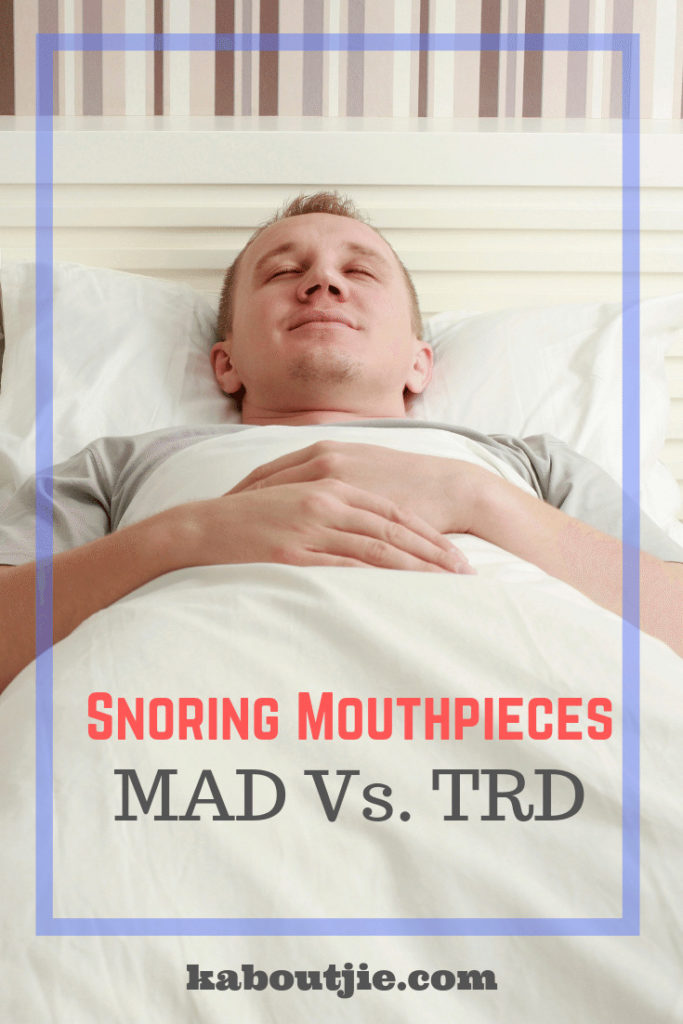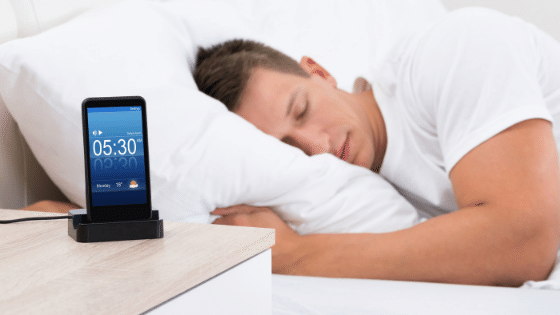Does your snoring keep you from getting a good night’s rest? Is it finally time to correct your snoring issue? Many people find relief from a snoring mouthpiece. If your doctor has recommended this option, we can help you find the right snoring mouthpiece.
There are two major types of stop snoring devices: MAD and TRD. We will tell you more about each of these devices later in this article.
Are you worried about which one to get? Don’t worry, as we will help you get started on the research for finding the best product for your situation.

What is Snoring?
According to WebMD, “snoring occurs when the flow of air through the mouth and nose is physically obstructed. Airflow can be obstructed by a combination of factors.” Some of those factors include nasal obstruction from either allergies or issues with a deviated septum, being overweight, or having too much alcohol before bedtime.
Snoring is the sound made when airflow is restricted at the throat. Basically, your tongue is blocking the air passage by falling back into the throat. Occasional snoring is merely a nuisance, but habitual or regular snoring can affect your sleep quality, leading to other health issues.
Models of Snoring Mouthpieces
If your physician has recommended a snoring mouthpiece, you have two major types to look at. The two most popular mouthpieces are MAD, or Mandibular Advancement Device, and TRD, or Tongue Retaining Device. TRD’s are also known as TSD (Tongue Stabilizing Device).
According to the Mayo Clinic, a snoring mouthpiece is an oral appliance that keeps your tongue, soft palate, and jaw in a forward position where air flow is not blocked.
These mouthpieces both work to keep the tongue away from the back of the throat by encouragement to stay towards the front of your mouth.
MAD (Mandibular Advancement Device)
The MAD is the more popular choice for customers, but it is not the right option for everyone. The primary feature of a MAD appliance is that it moves and keeps the lower jaw forward.
The American Sleep Association describes a MAD as a unit that lowers restrictions in the flow of air by moving the lower jaw forward. This process keeps your tongue forward and not in the back of your throat. Remember as a kid drinking water from the garden hose? If we folded the hose, the flow of water was restricted. Once the hose was straightened, the water flowed freely.
MAD’s are custom fitted to a patient. The result is the lower jaw moves forward, while the upper jar stays in place.
There are three distinct types of MADs:
- “Boil and Bite,” available at most pharmacies as an over-the-counter product.
- Partially-custom devices, made by taking a mold from your teeth.
- Fully custom made by your dentist or a lab that specializes in sleep devices.
You can expect to pay from $40 up to $2000 depending on the style you choose.
What are the Pros of a MAD:
- MADs are adjustable to allow for better efficiency.
- A MAD allows for breathing through the mouth.
- If you grind or clench your teeth, then a MAD device will help you.
The Cons of a MAD:
- MADs can not be used if you wear dentures.
- MADs cost more than comparable TRDs.
- A MAD pulls forward on the jaw and this can cause your jaw to be sore or painful.
- MADs are fitted, and this could require seeing a professional if required by the type of MAD you want.
TRD (Tongue Retaining Device)
The name gives it away. A TRD/TSD works with your tongue. This unit looks similar to mouth guards that athletes wear and is made of similar materials. The TRD is a more comfortable fit for the mouth.
A TSD works by gently pulling on the tongue which keeps it from falling back into the throat. This process eliminates snoring. The TSD attaches to the tongue by use of gentle suction. The front of the device braces against the lips or teeth according to the American Sleep Association.
Pros of a TRD:
- TRDs usually cost less than similar MADs.
- TRDs work very well with patients who wear dentures.
- TRDs will fit almost every user.
Cons of a TRD:
- If you have allergies, or a deviated septum, or just have other problems breathing through your nose, you’ll need to look at a MAD instead.
- Since a TRD is constantly pulling on the tongue by suction, soreness in the tongue can be experienced.
- TRDs are not an adjustable device.
Should I Get a TRD or a MAD?
There is no simple answer for which product to purchase. Ask your doctor for their input based on your medical history. There may be existing conditions that automatically eliminate one of the two. Ultimately, it may come down to trial and error to see which snoring aid works the best for you.
You might also discover that what works today may not work tomorrow. There are a couple of considerations to look at before making your final decision.
Snoring May Be a Serious Issue
If you snore, it can be an indication that you have a health issue that needs to be addressed by your physician. Your doctor can look at your medical history and other symptoms to determine if you need a sleep study, or if your snoring is just a minor irritation to you and your partner.
If you are overweight, losing some of those extra pounds can reduce snoring (along with the obvious other benefits). If you sleep on your side instead of on your back that can also help. But sometimes, snoring requires more interventive measures, like a CPAP (Continuous Positive Airway Pressure) mask. Surgery is also an option in some cases, including a tonsillectomy, or to repair issues with the nasal cavity.
Just because you snore does not mean you have a sleep disorder. However, if you are still tired after a full night’s sleep, have headaches or a sore throat after you wake, or your partner tells you that your breathing stops for a moment while sleeping, then it is time to visit your doctor and see if you may have a sleep issue.
Here’s to a restful night!
 Kaboutjie SA Mommy Blogs by Lynne Huysamen
Kaboutjie SA Mommy Blogs by Lynne Huysamen








Thank you for sharing